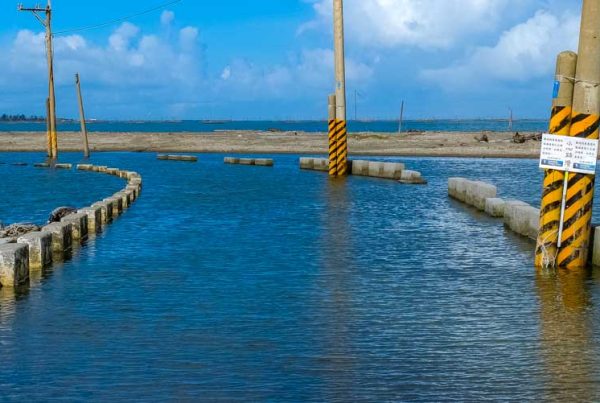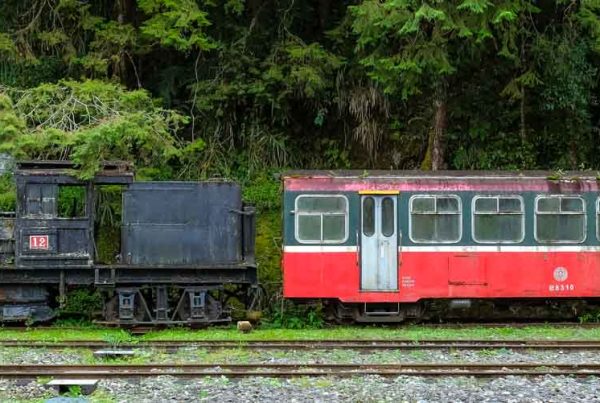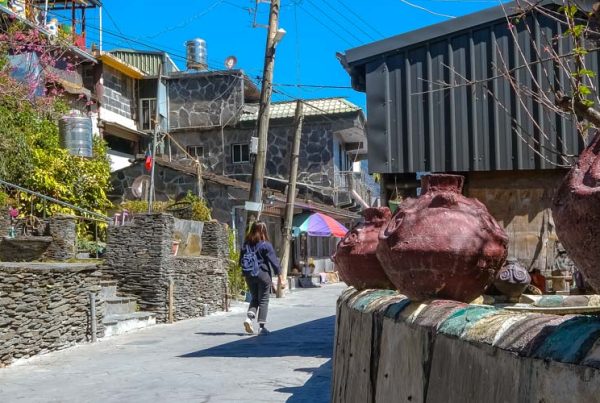Exploring Chiayi County & City in Three Different Styles
TEXT / RICK CHARETTE
PHOTOS / VISION
Chiayi County, in Taiwan’s southwest, stretches from the waters of the Taiwan Strait across the fertile Jianan Plain and up toward the sky in the majestic central mountains, past the Alishan National Scenic Area and falling just short of Taiwan’s pinnacle, the peak of Mt. Jade (Yushan), 3,952m high. Out on the plains, not part of the county, is old, quiet Chiayi City. This is the most popular jumping-off point for Alishan journeys. It is easily accessible from Taipei by train (Taiwan Railways and Taiwan High Speed Rail) and inter-city bus. Following you’ll find three theme tour suggestions to explore Alishan’s famed tea farms and alpine forest railway, and Chiayi City’s dense concentration of heritage architecture.
Tour 1 – Tea
If lacking your own wheels, the best way to explore the Alishan National Scenic Area’s tea farms is the Taiwan Tourist Shuttle service (www.taiwantrip.com.tw). There are two Alishan routes, Route A from Taiwan High-Speed Rail Chiayi Station and Route B from Chiayi Railway Station. Both ply Alishan’s main road, Provincial Highway 18, with the Alishan National Forest Recreation Area as terminus. This is a hop on/hop off service, with many stops along the way, making for easy visits to the attractions recommended below.
Alishan high-mountain oolong teas are among Taiwan’s finest, enjoying renown far from this island’s shores. The forest recreation area is located about 2,200m above sea level, while Alishan’s tea farms primarily inhabit the cool and foggy 800m~1,600m zone.

Should you just have one or two days to explore the world of Alishan’s mountain-slope tea plantations, what follows are what this writer considers must-not-miss experiences:
The Shizhuo Trails is a network of five comparatively short footpaths laid out on the steep slopes, lined with grids of tea bushes, above the village of Shizhuo. YuYuPas Cultural Park (www.yuyupas.com; Chinese) celebrates the culture of Alishan’s original inhabitants, the Tsou Tribe. Tea (and coffee) is also grown and sold here, with teahouses offering magnificent views in large thatched-roof structures evoking traditional Tsou meeting halls. You can also buy tea at FKUO Tea (www.facebook.com/fkuoo)and Sheng Li Farm (www.slfhs.com; Chinese). The former, run by a proud Tsou Tribe warrior, also has a restaurant preparing hearty Tsou/Paiwan tribe fare. The latter has an airy retail area, rustic café/Chinese eatery with big panorama windows, and a homestay facility.





If you have more than one day for exploring Alishan, you’ll need accommodation, right? High-quality comfort and superb shanshui-style scenery awaits at Tea Garden Homestay (www.alishan-home.com.tw; Chinese), where the two interconnected buildings were originally the courtyard-style home and tea factory of the young owner-operator’s grandparents, and SunSweetHouse (www.sunsweethouse.com; Chinese), a bright-colored facility resembling a California mission-style villa.




Tour 2 – Forest Railway
Bus and self-drive are not the only ways to soar into the sometimes blue-skied, often thick-misted Alishan mountain fastness. Train it! One of Taiwan’s most popular tourist attractions is the wonderful Alishan Forest Railway, a narrow-gauge heritage line built by the colonial Japanese in the early 1900s that takes you up from the Chiayi City plains to alpine country using evocatively romantic period locomotives and carriages.

For more railway detail, including timetable/ticket info, visit the Alishan Forest Railway Ticketing System (afrts.forest.gov.tw/TP01_1_E.aspx). Visit afrch.forest.gov.tw/en for a map showing all of the many stations, plus brief introductions on each, including elevation and distance markers. There’s one train each way daily on weekdays, three on weekends/holidays. Note that the trains run a tight schedule, so riders cannot disembark and re-embark at the stations along the way.

The full line goes up to the Alishan National Forest Recreation Area. Currently, however, the last stop is at a tiny hamlet called Shizilu – a section of line past Shizilu is under repair. From here, catch one of the Taiwan Tourist Shuttle buses mentioned above to the recreation area at the highway-side bus stop just 30m from the train station. (Note, you can also get off at Fenqihu and transfer to a Taiwan Tourist Shuttle bus there.)

Shizulu has a forgotten-in-time quality. There are numerous historical buildings track-side, including former Japanese worker dormitories. Enjoy steaming Alishan-bean coffee at the quaint track-side MXCoffee café (www.facebook.com/maxwucoffee). There’s also a track-side lookout platform with grand views north, info signboards, and b/w historical photos.

In the forest recreation area, ease into a sumptuous Alishan Hotel stay (www.alishanhotel.com.tw), surrounded by thick tall-tree forest. It has two sections, one dating to the 1895~1945 Japanese colonial era, the other a chic modern architectural statement opened in 2012. Early-bird it next day for the Zhushan Sunrise Watching Train, which chugs up-mountain from the recreation area’s Alishan Station to a high plateau from which the glorious sunrise over the distant 11-peak Mt. Jade massif is enjoyed (return service).



Tour 3 – Chiayi City
Chiayi City is easy-paced and small, with just 264,000 residents. Its compact old core, centered on the Chiayi Railway Station, is choc-a-bloc with places of historic interest. Check the YouBike map for Chiayi (en.youbike.com.tw/region/chiayi/stations) and you’ll see two things on the map shown. First, you’ll see that the roads around the core’s perimeter roughly form a circle – these follow the contours of the imperial-era city walls. Second, you’ll see that the core is also choc-a-bloc with YouBike stations – and perfect for city history explorations, on foot for places closer to the train station, on two wheels for those nearer the perimeter.

If your time is limited, do not miss these highlights:
The Chiayi Art Museum (chiayiartmuseum.chiayi.gov.tw) consists of three historic buildings, the main one a modernist work dating to the Japanese colonial era that served as a government office. See our “Mazu and Museums” article on page 22 in this issue for more on the Museum of Old Taiwan Tiles (www.1920t.com).



Alishan Forest Railway Garage Park, Beimen Station, and Hinoki Village form a treasure-house trio on Chiayi County’s forestry history. The garage park contains the former Alishan Forest Railway headquarters repair/maintenance garage and an impressive collection of antique imported locomotives and other rolling stock. Alishan cypress-built Beimen Station, original launch-point for the forest railway, is today one of two city forest railway passenger pick-up points. Hinoki Village – “hinoki” is the Japanese for “cypress” – is a complex of about 30 Japanese-built bungalow-style structures, most of these former forestry-industry worker dormitories, that today house food-and-beverage enterprises, arts-and-crafts boutiques, history exhibits, etc.




Nearer the old core’s perimeter, the Chiayi Old Prison, opened in 1922 and closed in 1998, is now a museum. Large, pleasant Chiayi Park, established by the Japanese in 1910, has an arboretum and a landscaped area. Two other highlights are its 62m-high Sun-Shooting Tower and elegant Chiayi City Historical Relic Museum, housed in two exquisite Japanese-constructed wood buildings.











